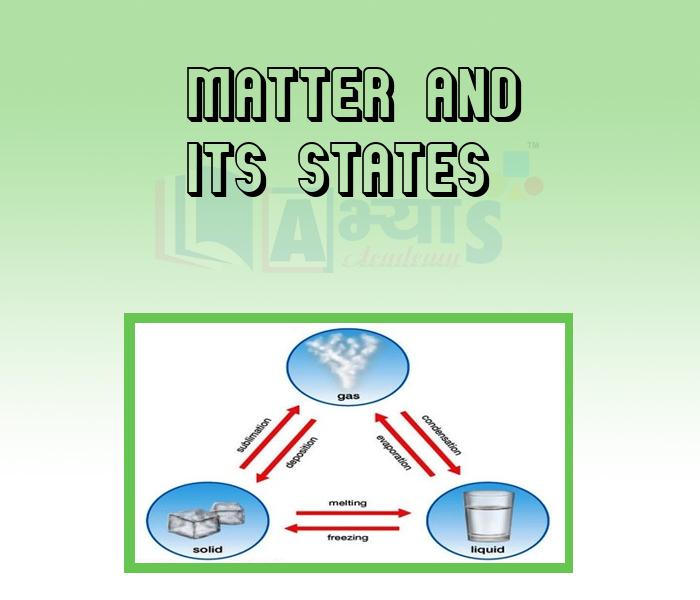Matter And Its States










Matter And Its States
Introduction: Chemistry is the science of the composition of matter, its properties and characteristics, and the changes it undergoes. Chemistry deals with the properties that distinguish one another.
The burning of coal, gas, and wood; the cooking of meat and other foods; the rusting of the kitchen knife and the tarnishing of silver - all these things, which we take for granted, involve chemical changes. Life processes such as growth, digestion and breathing are also examples of chemical change.
States Of matter: The physical classification separates matter into three categories - solids, liquids and gases - known as the three states (phases) of matter. Plasma, highly ionised gas, is sometimes considered a fourth state of matter.
Elements, Compounds and Mixtures: An element may be defined as the simplest form of matter that cannot be decomposed by ordinary chemical means into simpler substances, nor can it be formed by the combination of other substances, or an element is a substance made up of atoms with the same atomic number.
The common examples of elements are hydrogen, oxygen, nitrogen, iron, gold, copper, mercury, carbon, etc. There are 106 elements known at present. Out of these, about 92 have so far been found to occur naturally and the remaining 14 have been prepared in the laboratories.
Oxygen and silicon are the most common elements and they are the major constituents of sand, soil and rocks. Oxygen also occurs as free element in the atmosphere and in combination with hydrogen in water. The most common elements found in 'our body are oxygen, carbon, hydrogen nitrogen, calcium, phosphorus, etc.
A number of elements, found in only very slight traces or not at all in nature, have been synthesised. Those elements are technetium, promethium, astatine, francium and all the elements with atomic number above 92.
Compound: It may be noted that a chemical compound always contains the same elements in definite (fixed) proportion by weight. For example, water always contains hydrogen and oxygen in the ratio of 1:8 by weight. Thus, we may define a compound as a substance made up of two or more elements chemically combined in a fixed proportion by weight, A compound has properties all its own.
Mixtures: Most of the objects that we see around us are not pure substances (like elements and compounds) bat these are mixtures because they contain two or more substances in different proportions. A material obtained by mixing two or more substances (elements or compounds) in any proportion is known as mixture.
Mixtures are of two types: homogeneous mixtures and heterogeneous mixtures.
Students / Parents Reviews [10]
My experience was very good with Abhyas academy. I am studying here from 6th class and I am satisfied by its results in my life. I improved a lot here ahead of school syllabus.

Ayan Ghosh
8thAbhyas Methodology is very good. It is based on according to student and each child manages accordingly to its properly. Methodology has improved the abilities of students to shine them in future.

Manish Kumar
10thMy experience with Abhyas is very good. I have learnt many things here like vedic maths and reasoning also. Teachers here first take our doubts and then there are assignments to verify our weak points.

Shivam Rana
7thOne of the best institutes to develope a child interest in studies.Provides SST and English knowledge also unlike other institutes. Teachers are co operative and friendly online tests andPPT develope practical knowledge also.

Aman Kumar Shrivastava
10thA marvelous experience with Abhyas. I am glad to share that my ward has achieved more than enough at the Ambala ABHYAS centre. Years have passed on and more and more he has gained. May the centre flourish and develop day by day by the grace of God.

Archit Segal
7thIt was a good experience with Abhyas Academy. I even faced problems in starting but slowly and steadily overcomed. Especially reasoning classes helped me a lot.

Cheshta
10thAbout Abhyas metholodology the teachers are very nice and hardworking toward students.The Centre Head Mrs Anu Sethi is also a brilliant teacher.Abhyas has taught me how to overcome problems and has always taken my doubts and suppoeted me.

Shreya Shrivastava
8thIt was good as the experience because as we had come here we had been improved in a such envirnment created here.Extra is taught which is beneficial for future.

Eshan Arora
8thI have spent a wonderful time in Abhyas academy. It has made my reasoning more apt, English more stronger and Maths an interesting subject for me. It has given me a habbit of self studying

Yatharthi Sharma
10thBeing a parent, I saw my daughter improvement in her studies by seeing a good result in all day to day compititive exam TMO, NSO, IEO etc and as well as studies. I have got a fruitful result from my daughter.
